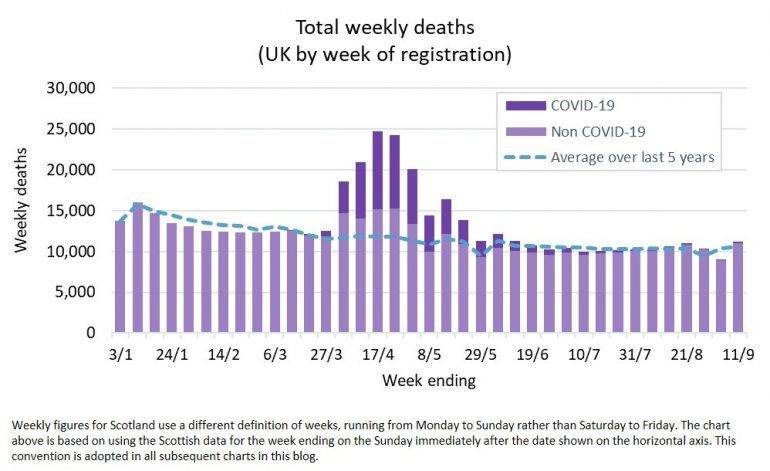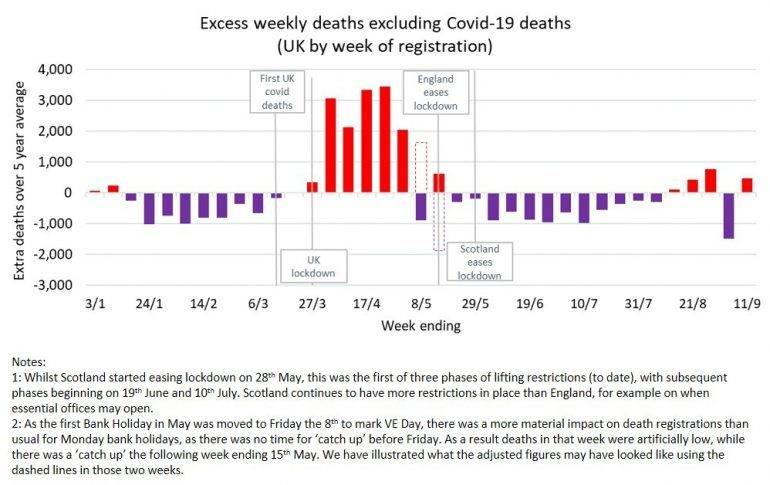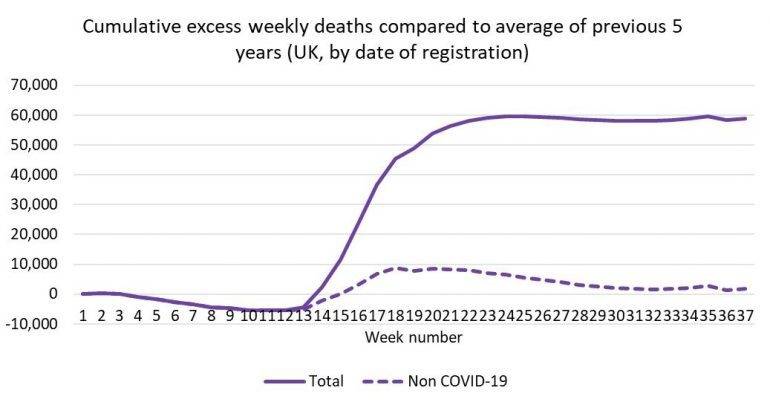In this week’s blog we explore the latest data on weekly deaths, which are once again above seasonal norms. Both COVID-19 and non COVID-19 deaths have increased in the latest reported week.
This is in part due to the timing of the August Bank Holiday in the UK (except Scotland), which reduced the deaths registered in the previous week. However, the overall upwards trend seen in recent weeks, relative to seasonal patterns, remains a cause for concern.
The past week has seen large parts of the North-East, North-West and Midlands added to the Public Health England ‘watchlist’ as areas of concern, with tighter regional restrictions imposed. Local lockdowns are being extended to more areas in Wales, while existing local restrictions have been extended nationwide in both Scotland and Northern Ireland. Our recent blog post explored the continued rise in case numbers across the UK and highlighted why the areas covered by the new regional restrictions were of concern. Further nationwide restrictions are now being brought in which restrict hospitality opening hours in the home nations governments’ attempts to suppress new infections. As temperatures fall, and indoor interactions would be the seasonal norm, it will be important to keep a close eye on case numbers in the weeks ahead, as they forewarn of potential hospitalisations and deaths to come.
Weekly deaths are again above seasonal levels
The latest statistics from the ONS include detailed breakdowns of deaths registered in England & Wales up to 11th September. In particular, they identify deaths where there is any mention of COVID-19 on the death certificate. Combining this information with similar data from the corresponding statistical bodies in Scotland and Northern Ireland, we can examine emerging patterns in the data.
The latest data shows that the total registered deaths in the last reported week were above the average for the time of year. The numbers of both COVID-19 and non COVID-19 deaths are both up on the previous week, with deaths increasing by more than the increase in seasonal average for the latest week.

The weekly death figures are based on date of registration (rather than date of death) so can be impacted by events such as Bank Holidays, when registration offices are typically closed. In last week’s update I discussed how the impact of the August bank holiday could be seen in the weekly data, in particular as the bank holiday was in week 36 this year, but had been in the preceding week in four of the five previous years. As a result, weekly deaths being above average two weeks ago, then below average last week was not unexpected. The fall in deaths last week was greater than we typically expect to see due to bank holiday effects, as although the registration offices may have been closed on the Monday, there is usually time to ‘catch up’ before the Friday. This may simply be statistical noise but it could also indicate an underlying death registrations issue which could influence the interpretation of statistics in neighbouring weeks. We continue to seek to understand this.
Non COVID-19 deaths above average levels
Non COVID-19 deaths saw a sharp rise around the same time as the pandemic started to impact in the UK in April (what we termed ‘missed’ deaths, shown in red in the chart below), but had returned to the early 2020 trend of being below seasonal levels.
However, since early July non COVID-19 deaths have been creeping steadily up (as seen in the decreasing purple bars) and had been higher than average for three successive weeks, before falling sharply last week (noting that timings of the August Bank Holiday may have impacted the last two weeks). The latest weekly data, which will not be impacted by the bank holiday, shows the non COVID-19 deaths are once again above the seasonal average.

Many medical professionals have been concerned that COVID-19 related reductions in the availability and uptake of medical care would result in a rise in non COVID-19 deaths. The trend seen in recent weeks (notwithstanding the bank holiday adjustments) is concerning, as it may be a sign of this feared rise coming through. The return of deaths being above seasonal average is concerning, particularly given the upwards trends seen since early July and the prospects of entering the winter months with elevated non-COVID mortality at the same time as a potential resurgence of COVID.
There is inevitably some volatility in these weekly deaths, as well as the impact of events such as bank holidays, so some caution is required in interpreting them over short periods. However, the return to the overall trend of steady increases is something we will continue to keep a close eye on.
What is the position for the year to date?
Cumulative deaths in the UK rose rapidly as a result of the pandemic, which we estimate has led to a loss of life in excess of 72,000. As a consequence the relatively light start to the year quickly unwound, and by mid-June cumulative deaths for the year to date were almost 60,000 higher than the corresponding weekly average values over the past 5 year (the solid line in chart below). For the past 3 months the cumulative excess mortality has been broadly stable and of the order of 10% of the typical annual total for the UK.

The chart reminds us of the sudden and dramatic emergence of COVID-19 and its impact on UK mortality. There are several warning signals fuelling concerns that we could be entering a fresh phase of rising excess deaths in the weeks ahead, including:
- the continued rise in new COVID-19 cases across various parts of the country; and
- recent increases to both the daily new admissions to hospital of COVID-19 patients and use of mechanical ventilation with these patients.
The prevailing upwards trend in non COVID-19 death figures relative to average levels over the last few weeks (out-with the bank holiday impact) also highlights the risk of broader health impacts arising from the pandemic.
As the increased restrictions being implemented across the country demonstrate, we continue to walk a delicate tightrope between maintaining services to protect broader public health and the economy, whilst targeting interventions in order to contain the direct and indirect loss of life from COVID-19.
“All of the team at Club Vita wish to extend our condolences to anyone who has personally been touched by bereavement in recent months. We know that these deaths leave behind people who are missing loved ones. Our thoughts are with you…”




